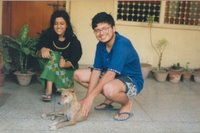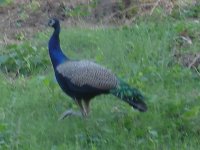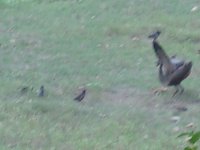My friend Bhavana keeps asking me to write a love story on my blog. I have put it off till now, saying I don’t have any such thing worth writing in my life, and I can’t write made up stories. But today I’m going to write about someone who loved me more than she loved herself. An unconditional kind of love. As long as she was in my life, she was my best friend. Her name was Minnie.
We met for the first time on a cold foggy winter morning in Allahabad; probably in late November, or in December… who remembers now? It was a long time ago: I was still in school. It was a holiday for me, my sister and my father. We had just settled down to a warm cup of coffee when we heard a squeak from outside our front door. I opened the door and went out, and there they were, sitting on our doormat. Two tiny mongrel puppies probably only a few days old. Chasing them away was difficult, for they had not yet learnt to be afraid of the usual threats from humans. They returned the next day, and again the next. Their mother was old and sick and had short legs due to a congenital defect not uncommon in Indian street dogs. She lived in the lane next to our house. We felt sorry for the pups and took bits of stale bread from my mother to feed them. Next day we found our milkman pouring a little milk on the ground outside our gate for them to lap up. Soon, they were bigger, stronger and faster. We used to blow an old dog whistle that we had while feeding them, and they quickly learnt that it was the dinner bell.
They also learnt to be afraid of us. Not the really-scared kind of afraid, but the curiosity-mixed-with-awe kind of afraid that children feel when their parents tell them that a house is haunted. They came to our verandah, and gave little barks, and ran away just outside the gate when we came out. Our gate had gaps that were large enough for them to pass. One of them was plain brown coloured. He used to wander away from his mother and explore the locality. One day he vanished and never returned. We believed that he had found an owner. The other one was ugly brown mottled with black stripes. She used to stay close to her mom and was friendlier towards us. The kids of our colony named her Minnie, and her mom Molly.
All through the winter they kept visiting our house and our bond grew stronger. I still remember the day when Minnie first let us touch her. As long as I and my sister patted her on the head she enjoyed it. As soon as we stopped she ran outside the gate, as if she had done something forbidden. No, she was not soft and cuddly like the puppies you see on TV; she was hard and bony to touch, and her coat was quite rough and full of ticks.
As winter turned to summer, Minnie and Molly started spending more and more time in our house. Minnie had grown quite a bit by this time, and was proving to be more like a pig in a dog skin rather than a true dog. She was one of the ugliest looking dogs I’ve ever seen, and her habits weren’t helping to improve her image. Allahabad summers can be harsh, and Minnie’s way of dealing with it was first dipping herself into the drain by the roadside so that she was covered in black mud, then climbing up onto our verandah and lying down in the shade. There she dried her mud and it fell down as dust all over the floor. Naturally, this routine was repeated everyday just after our cleaning was finished. Sometimes our wet garden soil would become her bed. And we would have a hard time getting her out of there. She would pretend to be asleep, and continue to do so even if I moved around her paws and tried to pull her up. If I parted her eyelids with my fingers, it would become obvious that she was awake and she would quickly shut them tightly again. She usually didn’t mind our scolding, though we had reason to believe that she understood every single word.
Once I opened an umbrella in front of her face. That scared and insulted her so much that she went down the steps and lay down in the hot sun to show off her anger. The ground was very hot and she kept fidgeting. My sister tried to coax her back onto the verandah, and as she was climbing back up, I remarked, “Huh, she has to come back here, doesn’t she? She can show off her anger but she has no other place to go!” Oddly, she heard that and quickly went back down the steps and into the sun again. She went away a little later, probably to her mom. However, her anger never lasted long, and all differences were forgotten by the next meal time. As I blew the whistle, she would run to our gate and, as if to remind us of her insult a little while ago, would sit down outside with her back to us. Then we would have to go and cuddle her and scratch her head and back and tummy and she would be happy to come and eat again.
Summer progressed. Minnie and Molly spent more time on our verandah now. We did not want them to become dependent on us, because it would be difficult for them when we went away on vacation. Due to some reason, the other dogs of the colony did not like them and fought with them. But teaching Minnie to survive alone was a pain now. Anyone who has seen the movie “Born Free” will understand what I mean. She was becoming more and more attached to us. Somehow miraculously, she could still pass through a gap in the gate that seemed way too narrow for her. Molly could not enter unless we opened the gate and let her in, so she used to come and knock at the gate. We usually turned them out at night after dinner, but on some nights they stayed inside. Once or twice they tried to come inside the front door, but we never encouraged that.
Though short and old, Molly was very beautiful and we jokingly said that she must have had a
Welsh corgi parent. Another puzzling thing was that while I tried to teach Minnie to ‘shake hand’ with us in vain, Molly promptly lifted her paw the first time I stretched out my hand to her, without any training. She used to bark at visitors and chase away cows from in front of our gate. Not so with Minnie, whose only jobs were eating, sleeping and whining in complaint if she didn’t like her food. They were sitting on our verandah when we left for Hooghly in our summer vacations. We later heard that they had been sitting there all through the vacations, guarding our house. A rod had broken off our gate so that even Molly could enter freely now.
I could go on and on with this story, for I vividly remember each little incident. But that would serve no purpose. This story has an abrupt end and let me come to that ending quickly.

When we returned from Hooghly, we found that they had left our colony. They had gone to live at a place about half a kilometre away. The first time I met them by accident there, and they acted literally like mad dogs. I particularly remember Minnie standing up on her hind legs with her front paws on my waist, and rubbing her head on my T shirt. She always behaved like this when they met anyone from our house there, and the other people around used to get scared thinking that we were being attacked by mad dogs. They sometimes accompanied us to our house and stayed for a couple of days before returning to their new den.
One day we did not see Molly any more. Minnie became alone. We used to meet her while going to the market, and sometimes we carried biscuits for her. If my mom cooked something good, she asked me to go and call Minnie. She used to come with me, but some time later, she stopped entering our house. Even if she did, she did not like us closing the gate. She had undergone a change. She sometimes used to come by herself in the evenings, and sit outside our gate, as if to tell us, “See, I’ve become independent now. I don’t need you anymore.” My mother was alarmed at this change. “Don’t touch her,” she told me one day, “she may have become mad”. I went to have a closer look at Minnie. She had become even thinner. As I went and stood beside her, she lay down on her back, lifted her paws into the air and waited for me to caress her. I knew instantly that no matter however much Minnie changed, she will always love and trust me as before.
Then one day Minnie disappeared. We couldn’t find her in any of her previous locations. I used the dog whistle to call her, but to no avail. We never saw her again. She could have been run over by a car, or fallen into the big open drain nearby, or killed by other dogs, or simply died of starvation or disease.
Or she may be still alive in some other locality where we didn’t search, hopefully with better owners than us, who can keep her well fed and inside their house.







